This project sought to evaluate Demand Response (DR) capabilities of residential refrigerators as part of an overarching investigation of multiple types of appliances. Several manufacturers have recently developed DR-capable appliances, but little is known about how DR capabilities will be implemented. This testing provided Southern California Edison (SCE) a better understanding of how refrigerators from a single manufacturer will react to certain DR signals before they are installed at customer sites. Testing was conducted under controlled environmental conditions in SCE’s Technology Test Centers laboratories.
An industry-devised protocol defines DR events as “Spinning Reserve” events (those with a duration less than 10 minutes) or “Delay Load” events (those with duration greater than 10 minutes and less than 4 hours), and requires specific responses for each type of event. These definitions need to be altered to provide more utility-focused benefit in order to promote widespread adoption of the technology.
Overall, the refrigerator performed as intended for Spinning Reserve events with demand reduction of approximately 100 W, depending on the conditions and components in operation at the time. For Delay Load events some of the expected responses did not materialize. In general the total power demand reduction of the refrigerator was approximately 10 W when the compressor was on, but there was a slight increase in power ~3 W during compressor off times. If all of the expected responses were active, the magnitude of reduction likely would have increased. In all instances, the refrigerator recovered from the DR event response in a short length of time. Unfortunately the effect of DR events on defrost cycles was only partially observed due to the difficulty in predicting the defrost initiation. It was also discovered that certain control lockout features inhibited its ability to respond to DR events in certain situations. It is recommended that manufacturers revisit control strategies with the goal of providing maximum benefit to the consumer, including allowing energy efficiency and demand response capabilities to operate simultaneously, ensuring all of the refrigerator’s expected responses actually occur, and removing the 24-hour lockout between events in favor of using the inherent sensing and control capabilities to determine when a response is proper.
Concurrent with this project, the US Environmental Protection Agency began investigating the optimal way to incorporate DR capability into its Energy Star appliance labeling programs. Findings from these projects will be used to help inform interested parties during the Energy Star development process. The full technical report will be available at www.etcc-ca.com in mid-2013.
Citation: ASHRAE Conference Papers, Denver, CO
Product Details
- Published:
- 2013
- Number of Pages:
- 8
- File Size:
- 1 file , 670 KB
- Product Code(s):
- D-DE-13-C010


